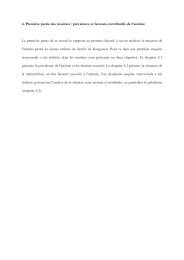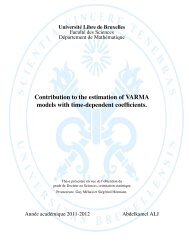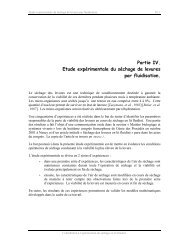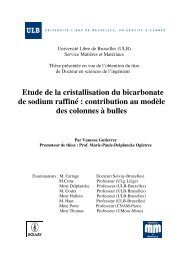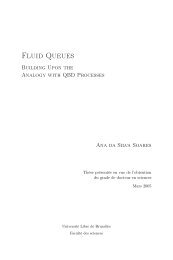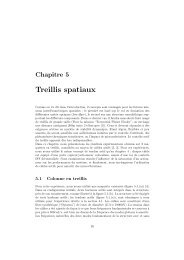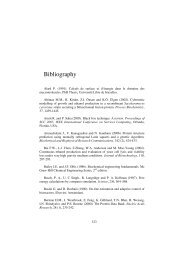Diapositive 1 - de l'Université libre de Bruxelles
Diapositive 1 - de l'Université libre de Bruxelles
Diapositive 1 - de l'Université libre de Bruxelles
You also want an ePaper? Increase the reach of your titles
YUMPU automatically turns print PDFs into web optimized ePapers that Google loves.
Chapitre VFigure 37: Scanning electron micrograph of precipitated mineral grown in presence of test proteinextract: (A) 1:1 Mg/Ca solution, 1 µg/ml protein, (B) 1:1 Mg/Ca solution, 5 µg/ml protein, (C) 1:1Mg/Ca solution, 10 µg/ml protein, (D) 4:1 Mg/Ca solution, 10 µg/ml protein experiments²DISCUSSIONThe magnesium concentration in the <strong>de</strong>posited minerals increased with the Mg/Ca ratio ofthe solution, as reported in previous studies (Falini et al 1994, Han et al 2005, Cheng et al2007). This factor had a predominant effect on magnesium incorporation in comparisonwith the nature and concentration of soluble organic matrix (SOM). So, a biologicalcontrol of the precipitation solution could be sufficient to reach elevated magnesiumconcentrations reported in biogenic calcites.Most cases of biologically controlled biomineralizations occur in a compartment isolatedfrom the external environment and <strong>de</strong>limited by a biological membrane (vacuole,intercellular space, Lowenstam & Weiner 1989, Simkiss & Wilbur 1989). The ioniccomposition in the mineralization compartment can therefore be strictly biologicallycontrolled by the exchanges through this membrane. Seawater Mg/Ca ratio has beenshown to influence the skeletal Mg/Ca ratio of calcifying organisms (Lorens & Ben<strong>de</strong>r1980, Ries 2004) to a certain <strong>de</strong>gree, and must therefore exert some influence on theMg/Ca of the solution in the calcification site. This <strong>de</strong>pen<strong>de</strong>nce to seawater Mg/Caindicates that some non-selective transport mechanisms, like diffusion, are probably alsoinvolved.However, the Mg/Ca ratio of the in vitro inorganically precipitated minerals far excee<strong>de</strong>dvalues measured in both past and present sea urchin skeletons. Using Ries’(2004)104



